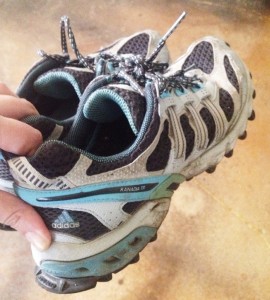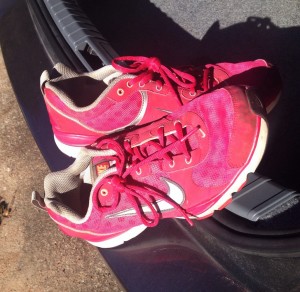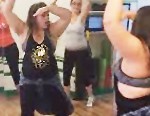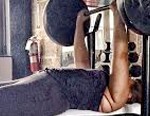Is it time to replace your shoes?
If you’re asking, the answer is probably yes!
If you’re feeling strange new hip or ankle pain when you work out that you never had before, that may be another sign that it’s time to hit the shoe store.
If the model of your shoe isn’t even made anymore…yes.
Most of us begin our commitment to fitness with whatever shoes we had in our closet already. This is a great and natural place to start, but as time goes on we begin to realize that we would be better off with the right shoes for the task.
For example, the horribly inappropriate shoes I had when I started Zumba: stiff soles, lots of lateral control (which isn’t good for dancing!), and several good hikes under their figurative belts already.

And the first pair of shoes I bought with Zumba specifically in mind: lighter, more flexible, and with less lateral/torsion control in the soles.

I am not a marketing rep speaking on behalf of the athletic shoe industry, just a trainer who cares about your joints and long-term health and happiness. That being said, please don’t be dismayed to hear that I’m going to recommend that you may need several new pairs of shoes if you are participating in several different activities.
Athletic shoes are not all created equal. There are different flavors for different activities, because they provide different types and levels of support. Even within a shoe genre, different models of shoes target different areas for support and offer varying levels of stability.
To choose the right shoe for your activity, you will need to not only keep your activity in mind, but no a little bit about what your specific body needs in a shoe. Your trainer or a qualified shoe sales representative (like the ones found a good fitness stores) can probably take a look at your gait and other movement patterns and help you make a good determination.
I have a broken down some of the activities for which I recommend owning different pairs of shoes below, and I have also provided the general timeframe is for replacement of the shoes. Keep in mind though, that if you are on the high end of the BMI charts, you may need to replace your shoes more frequently, as the force with which you are striking the ground is greater than the average force that is used when the general shoe duration recommendations were calculated. You can possibly stretch the life of your shoes by using new insoles, but that is a big topic for another day.
Activities that deserve their own dedicated shoes:
- Running – replace shoes every 500 miles (about once a year if you’re a beginner who runs 2-3 days a week)
Running-specific shoes are real! If you are beginning to run with some regularity, please go to a good running store (I love Luke’s Locker if you’re here in Houston – it’s right near Tiny Fitness, too) and get your stride evaluated by someone who is knowledgeable. Spend $100 on running shoes now and avoid future injuries, ok? You may need multiple pairs of running shoes if you are training for long distances and/or to increase your speed – for instance, as a new runner you might need stability shoes to correct over-pronation, but those shoes may be too stiff or heavy for speed workouts. You only get two knees in this lifetime, so treat them well, all right?An additional plea: if you are running in any semi-serious way, please please please reserve your running shoes only for running workouts. These aren’t lawn-mowing shoes, dog-walking shoes, grocery shopping shoes, or even Zumba shoes. Quality running shoes are designed for running, and other activities quickly break down their support mechanisms. - Cross-training workouts – replace shoes every 6-12 months
Cross-training shoes are flexible and provide just enough support and cushion to get you through brief plyometric (jumping/high-impact) training sessions. They’re good for strength workouts and the kind of workouts we do during personal training here at Tiny Fitness, and they can get you through your time on the treadmill or elliptical trainer if you’re so inclined. They don’t provide enough support for extended running workouts, and their usability for Zumba or other dance fitness workouts depends on the specific shoe model (as different shoes provide different levels of traction and stability). Just like running shoes, try to keep these shoes from becoming your all-around daily shoe; they’ll wear out faster and won’t provide the support you need for higher impact movements. - Zumba and other dance workouts – replace shoes every 6-12 months
You don’t have to buy dance sneakers for Zumba. Dance sneakers have pivot points (round, smooth areas) on the soles to allow easier turning by reducing friction; if you find yourself having knee or ankle pain after lots of side-to-side movement during class, you may want to try a pair of dance sneakers (or shoe slides) to see if the pain subsides. Any flexible, lightweight sneaker should do the job, but honor your body: if you need more support, find a shoe with more support! If your classes tend to be higher impact, look for a shoe that provides adequate cushioning. And if you do buy dance sneakers…you guessed it! Reserve them just for class to keep them in good condition and ready to support you through every sweaty second. - General-purpose sneaker wearing – your call
I’m only including this category to emphasize the point that your knockaround sneakers are not the same as your running, Zumba, or cross-training sneakers if you’re working out in a serious way! Go buy yourself those sequin platform hightops or the cute but unsupportive ones with the little bow at the front and go to town. Literally. But don’t let me see you in your running sneakers at the grocery store!


